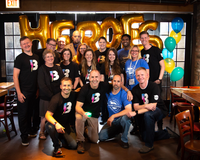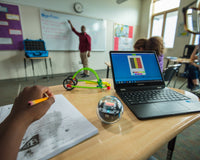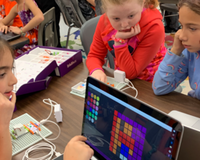In the last 18 months, students have adapted to new ways of learning—including switching between virtual and hybrid learning models on the fly.
During this time, many young learners experienced significant disruptions in their curriculum—such as schedule changes, glitchy technology, midyear teacher replacements, and at-home distractions. Unfortunately, these disruptions have led to many students experiencing learning loss and learning gaps in their education.
Although school districts and teachers did their best to protect their students and provide adequate distance learning environments, a recent research paper by McKinsey reports the impact of the pandemic on K–12 learning left students an average of five months behind in mathematics and four months behind in reading by the end of the 2020-2021 school year. What’s more, that same McKinsey report shows that pre-existing educational inequities were widened, as low-income schools with fewer resources felt the effects of this transformation the most.
As we approach the second half of the 2021-2022 school year, we are now realizing the long-lasting effects that learning gaps have had on our students—and it’s important to help bring them back up to speed while caring for ourselves, too. Making changes to a learning environment affects both students and educators, so let’s pause before considering any hard and fast solutions.
While data is not yet available on how the nation’s overall dropout rate was affected in 2020, anecdotal evidence suggests that fewer students are completing high school or moving on to postsecondary education. This is a major red flag.
The conversation is ongoing. Moving forward, educators should keep listening closely and look at what others are doing, so we can collaborate on finding ways to address this learning gap and avoid further learning losses—which could include getting creative with the resources we have, experimenting with new solutions, and learning from our fellow educators.
In this guide, I will help you break down just what a learning gap is, as well as describe some first-hand experiences I’ve had during the last 18 months while working as a long-term substitute principal at two different schools. I’ll also provide some ways educators can work to solve these learning gaps.
What is a Learning Gap?
A learning gap is a discrepancy between what a student has learned and what a student was expected to learn by a specific point in their education. While some learning gaps can be minor and relatively easy to remedy (such as a student missing a single lesson due to illness), others can be significant and cause major learning losses or academic setbacks.
The 5 Types of Learning Gaps
I’ve identified five core types of learning gaps that students can experience, including:
Learning Gap Examples
Having spoken with hundreds of teachers across the country during the last 18 months, many of these learning gaps educators had no control over. But two that stood out to me the most were knowledge and environmental gaps.
Knowledge Gaps
As I’ve come to understand it, the knowledge gap is somewhat of an exposure gap, as instructional experiences are different all around the country. For example, every school district handled distance learning in its own way, and some just simply didn’t have the technology or infrastructure to support students who were learning from home.
Some schools were able to seamlessly transition to distance learning, with teachers moving their instruction to Zoom in a synchronous way for most of the school day. These teachers were able to easily form Zoom breakout rooms as a way to lead student intervention, continue with book clubs, and provide any other necessary instruction to support their students.
For other schools, however, that transition wasn’t as smooth. Several teachers I’ve spoken with were only able to provide an hour or so of live teaching during the school day. In some cases, students were only given packets of worksheets or assignments that weren’t interactive and far from the same experience as learning in person.
Environmental Gaps
Environmental gaps are similar to knowledge gaps, but with different outcomes. I was a long-term substitute principal for seven months during the pandemic, and the school where I was working had students at home learning for about five of those seven months. My colleagues and I saw quite a few at-home learning environments that were far from ideal. This included things like:
- Limited space in family homes
- Inadequate or slow internet connections
- Siblings learning alongside other siblings
- Parents trying to work from home
While learning is not always a quiet activity, these environmental factors certainly took a toll on students’ learning abilities—especially after dealing with them for several months.
How can you identify learning gaps in your students?
Identifying learning gaps in your students can feel like an overwhelming undertaking, but there are concrete, systematic ways you can do this.
For example, analyzing standardized assessments across your school or district is paramount to identifying gaps in your students’ learning—but you won’t be able to do this by simply referencing 2020’s state assessment scores. To truly understand student proficiencies, you must analyze 2018-2019 student data—including both standardized assessments and performance-based tasks.
When looking at data from these two years, pay special attention to areas your students excelled in and areas that they weren’t as proficient in. This will help you refine your lesson plans to address learning gaps, get organized on student interventions, and target school resources to help struggling students.
To go along with analyzing standardized assessments, having your kids identify their own areas for improvement is important, as well. While the data tells one story, having the children articulate their areas of improvement helps them in their own learning.
Once your students’ learning gaps are identified, being able to introduce Tier I interventions for them is the first step. In some cases, Tier II interventions with small groups of students might be required in order to bridge a learning gap. If that’s not the case, identifying individual student needs and moving to Tier III interventions is paramount.
Bridging Learning Gaps with STEAM
The integration of STEAM (science, technology, engineering, arts, and mathematics) into your daily lesson plans is the best way to bridge learning gaps in students.
When STEAM-based activities are introduced into a remote or in-person classroom (specifically those that are interactive and introduce new technology concepts), I’ve seen students’ levels of interest multiply exponentially. These activities should also peak your interests, as they oftentimes enable you to teach multiple concepts at once.
Sphero and the Silk Road
With many students returning to in-person learning, consider new ways to bring STEAM into the classroom, too.
A great example of a successful STEAM-based activity that I’ve witnessed firsthand was a Sphero activity. While a teacher was educating students on the Silk Road using their textbooks, one of the students chimed in and asked if they could program their classroom Sphero robots to enhance their knowledge and understanding. While this wasn’t the teacher's idea, the teacher said yes!
The students gathered blue tape, their textbook that included the map of the Silk Road, and got to work building a model of it on the classroom floor. When their model was completed, they picked up their Sphero robots and started writing code so they could maneuver them around their Silk Road model. Talk about successfully integrating a learning tool that was already in their classroom!
Tip: You don’t need to be an expert with a Sphero robot or other types of STEAM learning tools at first. Let your kids lead the way. Don’t be the only teacher in the classroom—work with your students to go on the learning journey of STEAM together.
Remedying Learning Gaps, One Step at a Time
Lately, I’ve seen several memes on the internet of the “burned out teacher” and I know why. There are way too many programs and expectations that teachers are required to learn, teach, implement, and then assess.
We’ve become so overwhelmed by what our kids missed during the last 18 months—and all the work they need to do to catch up—that we’re trying to tackle too many things at once. Not only is this counterintuitive to remedying learning gaps, but it also leads to teacher burnout.
The same can be said for student burnout.
If we don’t constantly prioritize what’s most important for our kids and ourselves, everyone is going to be hanging on by a thread. If your students have gaps in their learning, we as teachers must focus on targeting our instruction towards closing those gaps one step at a time.
I don’t think the term ‘back to basics’ is accurate, but it starts to paint the picture of doing less, with more fidelity, to actually reach more students and make a bigger impact. You can do this by choosing one to three subject areas to focus on at first—but don’t settle on teaching these subjects or concepts how they’ve always been taught.
Try to incorporate a few STEAM-related activities (such as those that utilize interactive Sphero robots) into your lesson plans, as they will help you reach your young learners in a profound way. Once your students have mastered those areas, move on to another set.
And, if your school or district doesn’t already have one, enlisting the help of an intervention teacher (supported by paraprofessionals who are trained in research-based reading, writing, and math programs) can help support you as you work to bridge your students’ learning gaps.
Most importantly, pace yourself, lean on your colleagues for support and collaboration, and take care of yourself and your students.
About the Author:
Adam Welcome was Principal of the Year for his region in California, a 20 To Watch for the National School Board Association, guest blogger for EdWeek, NAESP magazine, and many other publications. Adam also consults and works with many education companies as a way to improve their product for others!
Adam is passionate about technology integration with all educators and a huge advocate of social media and connecting with other educators from across the country. Adam makes it clear that kids come first and has preached the message of Team Kid for many years.
He is also the co-founder of Kids Deserve It and author of four books. (Kids Deserve It, Run Like A Pirate, Empower Our Girls and Teachers Deserve It)
Adam has an amazing wife and two young children that keep life at home exciting and active. Adam also loves to run and has completed 30 marathons.
You can learn more about Adam by visiting his website at https://www.mradamwelcome.com/.










